Women Hairstyle | No Pain, No Rogaine: <b>Hair</b> Loss and <b>Hairstyle</b> in Ancient Rome <b>...</b> |
| No Pain, No Rogaine: <b>Hair</b> Loss and <b>Hairstyle</b> in Ancient Rome <b>...</b> Posted: 25 Aug 2015 11:50 AM PDT Hair obsessions aren't new. In ancient Rome, attaining the right style was a high priority for the upper-class man and woman 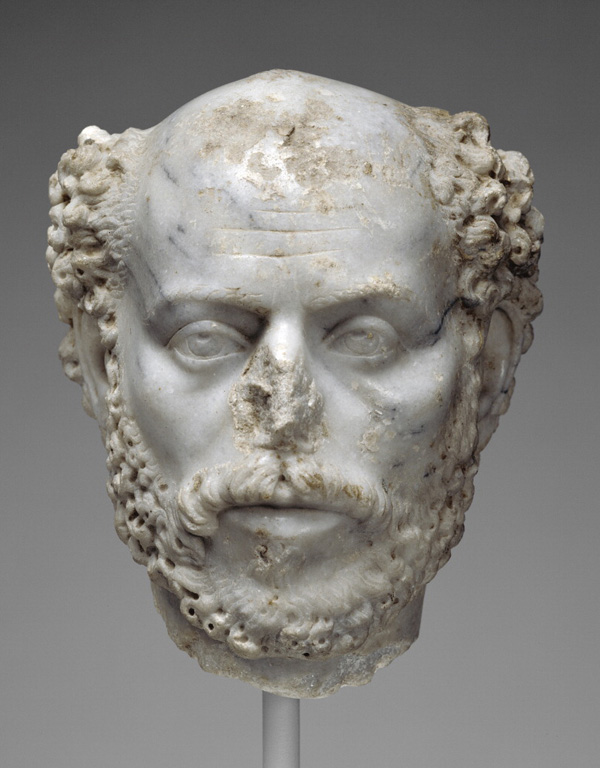 Portrait Head of a Balding Man, Roman, about A.D. 240. Marble, 10 1/16 in. high. The J. Paul Getty Museum, 85.AA.112
Much like Donald Trump, men and women in ancient Rome were very conscious of their coiffures. Roman attitudes toward hair (or lack thereof) differed immensely depending on age, sex, and social status, and was known to be a source of anguish for both Roman men and women. So although there's no evidence that Seneca actually said the zinger above, as an ancient Roman he definitely should have. As a classics student, my interests in the ancient world lie less in wars and dates, and more in recognizably human themes, such as vanity, the natural inclination to poke fun at your elders, and the timeless misery of hair. Male Baldness and Its DiscontentsA signifier of wisdom, gravitas (dignity), and severitas (sternness), male pattern baldness was considered an ideal characteristic of an upstanding Roman citizen, and was used to convey venerability on portraits of philosophers. 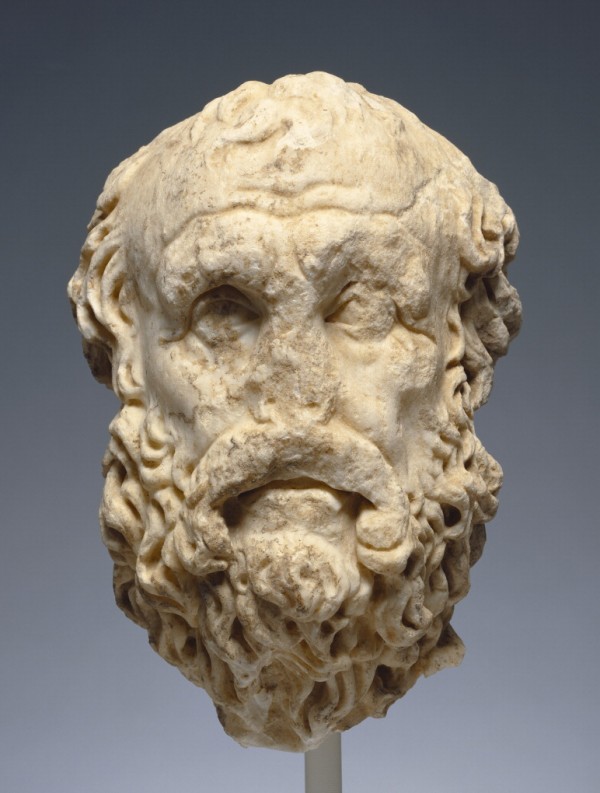 Portrait Head of Diogenes, Roman, A.D. late 100s. Marble, 13 in. high. The J. Paul Getty Museum, 73.AA.131 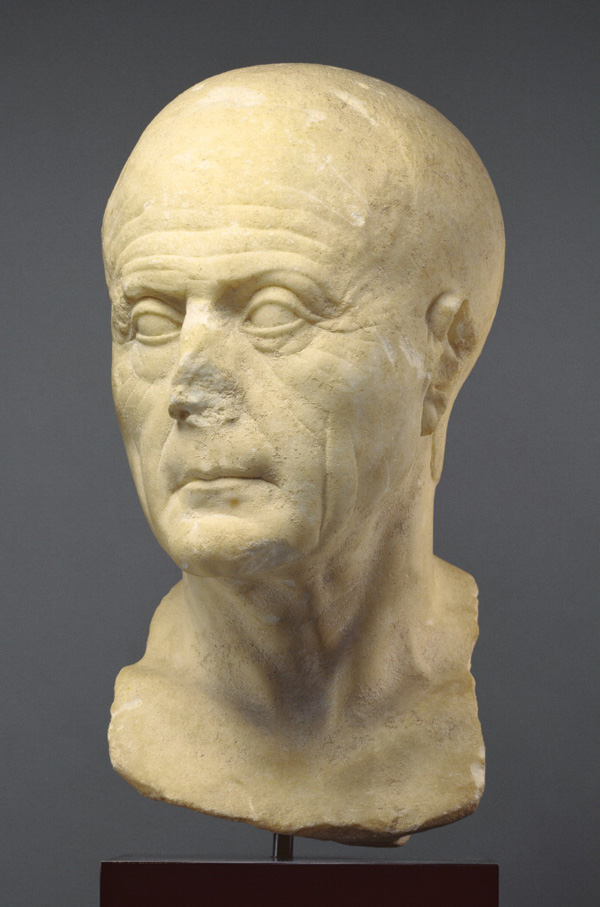 Head of an Old Man, Roman, 25 B.C.–A.D. 10. Marble, 13 15/16 in. high. The J. Paul Getty Museum, 96.AA.39 Image: Bruce White Photography Especially in the Republican period, from 509 to 27 B.C., Roman portrait patrons often chose to be presented with glisteningly bald heads, large noses, and extra wrinkles to express the years they had devoted to the Roman state. But despite the air of patriotism associated with baldness, it would seem that a receding hairline outside the realm of portraiture wasn't nearly as desirable. The famously bald (and somewhat defeatist) Emperor Domitian lost many a night's sleep over his hair loss (Emperors, they're just like us!):
The horror of baldness also appears in poetry:
Men would dye their hair and have it curled in an attempt to avoid greying or thinning, and to preserve any youthful, Jon Hamm-like features. As an example of the unfortunate propensities of real hair, see the wispy, greying locks of this stumbling and aged follower of Dionysos, tired after a long night of drinking. 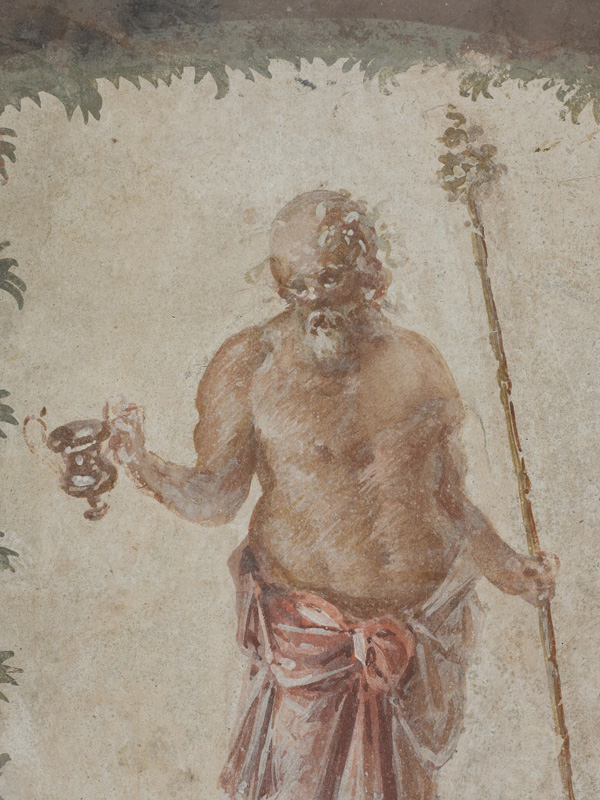 Fresco Fragment Depicting an Old Silenos with Kantharos and Thyrsos (detail), Roman, A.D. 1–100. The J. Paul Getty Museum, 83.AG.222.2 Hair dyes were often extracted from bark or walnut shells, carbon, or straight ash—materials also used to dye textiles. Because both balding and going grey were associated with deteriorating health and generally losing your marbles, hair dye proved a popular practice amongst Roman men. But dyeing one's hair also served as a prime opportunity for ridicule, and any man attempting to disguise a receding hairline was in for a relentless mocking from poets (and, presumably, sassy Roman teenagers):
So to be bald, or not to be? You can't win. Women's Hairy AgoniesJust like for men, hair was a major determinant of both respectability and physical attractiveness for women. Not unlike Kim Kardashian's beauty routine, hair was the first step in any Roman woman's prep, notes author Seneca. 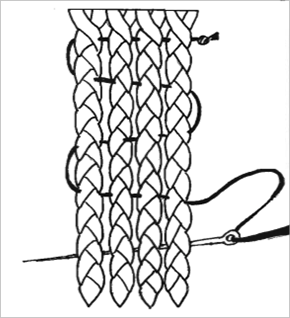 Roman braid-weaving from J. Stephens, "Ancient Roman Hairdressing: On (hair)pins and needles," Journal of Roman Archaeology 21 (2008): 111–133 All hair endeavors for the wealthy Roman woman would have fallen under the domain of an ornatrix, or beauty expert specifically skilled at cutting and dyeing hair—depicted, ironically, as short-haired throughout Greek and Roman art as suited her slave status. (See the slave's short hairstyle compared to her mistress's well-tended-to locks on this grave marker.) Such female hairdressers were also responsible for styling hair with dangerous hot tools such as the calamistrum (a cylindrical, fired curling iron), and for sewing in locks of false hair, most often in the form of braids (pictured). But female vanity, even more than male, was ceaselessly mocked:
A popular hairstyle that utilized hair extensions can be seen in these portraits of Julia Titi and an anonymous Roman woman. In both of these women's hairstyles, their extravagant curls are piled high and woven together in a pre-Marie-Antionette updo. 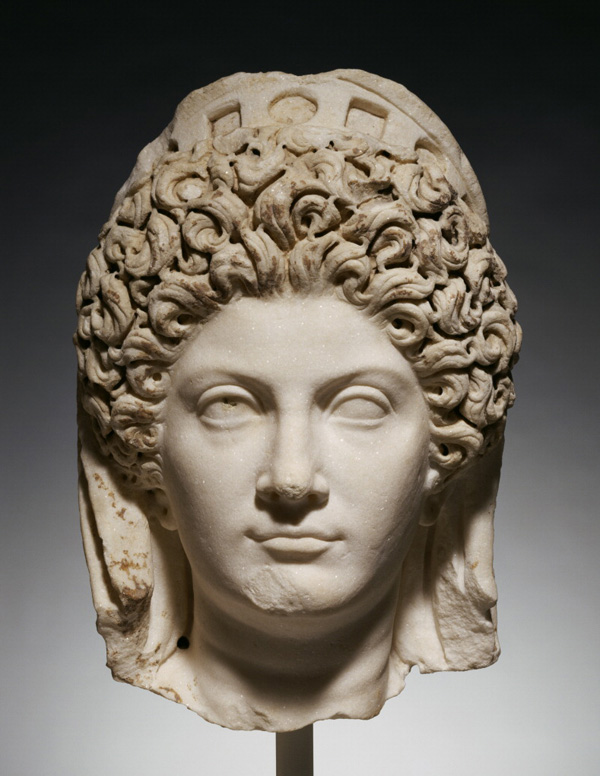 Portrait Head of Julia Titi, Roman, about A.D. 90. Marble with polychromy, 13 in. high. The J. Paul Getty Museum, 58.AA.1 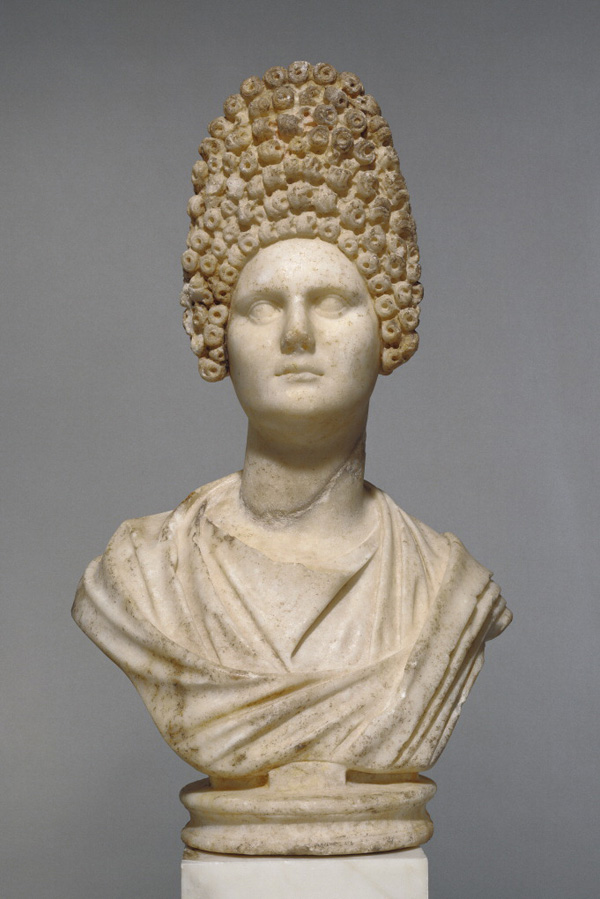 Bust of a Flavian Woman, Roman, late 1st century. Marble, 26 ¾ in. high. The J. Paul Getty Museum, 73.AA.13 Sometimes a more modest front view hid the extreme updo's reverse, which required long artificial braids and exceptional styling technique on the part of the ornatrix. Business in the front, party in the back! 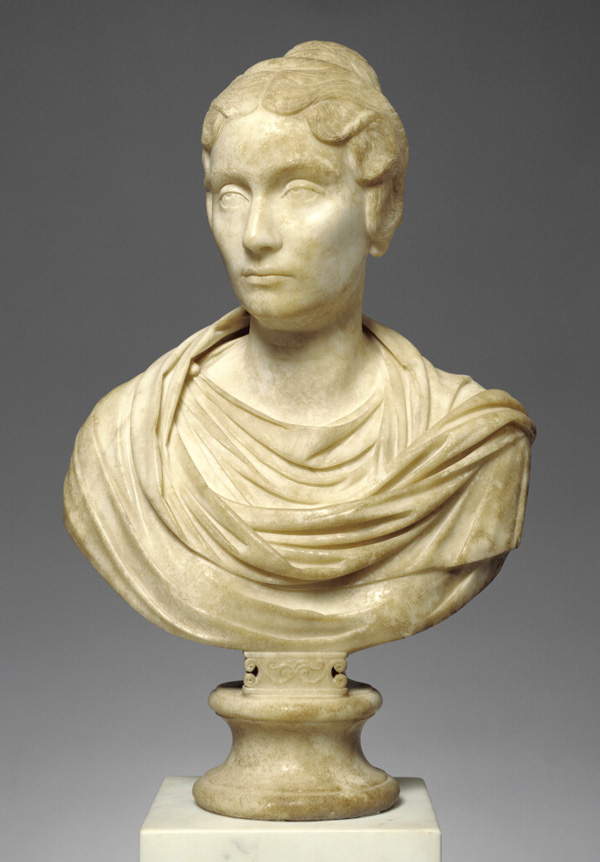 Business in the front. Portrait Bust of a Woman, Roman, A.D. 150–160. Marble, 26 9/16 in. high. The J. Paul Getty Museum, 83.AA.44  Party in the back. Here you can see a similar look reconstructed by historical hair rockstar Janet Stephens: For those who couldn't afford their own personal beauty team, there were local barbers and hairdressers. The barbers would do more than simply give you a trim; they would also clean and cut your fingernails, tend to calluses, and even remove warts and moles. No woman would have cut her own hair unless she were in dire financial circumstances. Many plebeians also wouldn't have owned proper combs, which provided a good excuse to go to the barber for a slice of town gossip. Aside from the hair on their heads, Roman women often opted for the naked mole rat look, bidding vale (farewell) to all bodily hair. For hair removal, many would pluck, use pumice stones, or wax off their hair using a paste made of resin. But like the toupeed men discussed earlier, older women who shaved were ridiculed, as this was seen as preparation for sex. Seems you can't win either, lassies. After having their hair prepped, Roman women would put on the final touches: shave their eyebrows (who needs 'em?), lace their eyelids with soot, powder their faces with lead (for that dreamy/poisonous white complexion), and rouge their cheeks with rust and/or wine. Unlike portraits of their husbands and brothers, portraits of Roman women were far more concerned with representing the latest ideas of fashion and beauty than the subject's actual features. Like men, however, Roman women also faced conflicting attitudes towards their outward appearance. Criticized for being both too made-up, and not made-up enough, the struggle for Romans of both sexes was all too real. Alas, we can't all be Farrah Fawcett. Still interested? See further reading below. Further Reading
|
| The Sharecropper's Daughter Who Made Black <b>Women</b> Proud of <b>...</b> Posted: 31 Aug 2015 11:29 AM PDT
American history books are filled with stories about titans of industry—invariably, white men like Andrew Carnegie and John D. Rockefeller—who cornered emerging industries and amassed incredible wealth at the expense of the public and their employees. Yet few know the name of Madam C.J. Walker, a black female entrepreneur who built a hair-care company from scratch and became one of the most powerful African Americans in the early 20th century. Unlike those corrupt businessmen of yesterday or the ones who rule Wall Street today, Walker offers an inspirational icon for our age—a woman who overcame great barriers to make it into the ranks of America's elite, choosing to reinvest her money in social causes and provide opportunity to those who had none.
At a time when black citizens were kept in poverty through violent intimidation and segregation, Walker's success was built on the strength of social networks, word-of-mouth testimonials, and products designed for an acutely underserved population. In many ways, Madam Walker's story is a classic rags-to-riches tale, wherein a poor orphaned girl pulls herself up through sheer determination and willpower, forming a business that becomes an industry giant and the envy of others. But Walker's story is also one of repeated frustration—that her various husbands took more from her than they gave in return; that her accomplishments were challenged or overlooked by others in the black community; that she barely lived long enough to enjoy her hard-earned prosperity. A'Lelia Bundles, Madam Walker's great-great-granddaughter, helped uncover Walker's unique legacy in her detailed biography, "On Her Own Ground: The Life and Times of Madam C. J. Walker," which was published in 2001. The title of Bundles' book was pulled from one of Walker's famous statements about her journey from poverty to success: "I am a woman who came from the cotton fields of the South. From there I was promoted to the washtub. From there I was promoted to the cook kitchen. And from there I promoted myself into the business of manufacturing hair goods and preparations. I have built my own factory on my own ground." Walker's struggle to escape a life of hardship and the help she received from other women inspired her to support philanthropic projects, particularly those that offered employment and economic independence for African American women. "Even though I had a long career in network television news, I think my real contribution to the world is to make sure her story didn't die," Bundles says. "Madam Walker is certainly more well-known now than she was when I did my first paper on her in graduate school, or when I wrote my first article about her in the early 1980s. All these little seeds have been planted, so that now there's even a Harvard Business School case study about her."  Top: Sarah Walker at the wheel of her Model T in Indianapolis in 1912. Image ©Madam Walker Family Archives/A'Lelia Bundles. Above: An advertisement for Madam Walker's hair products, circa 1910s. The details of Madam Walker's early life are hazy: She was born Sarah Breedlove in Delta, Louisiana, in 1867 to sharecropper parents who worked on a cotton plantation where they were previously enslaved. Both Sarah's parents passed away by the time she was 7, and she moved with her sister Louvenia and her sister's husband to Vicksburg, Mississippi, just across the river. Sarah didn't have the chance to attend school, and from around age 10, she began doing the difficult manual work of a laundress, which gave her a glimpse of the luxurious lifestyles enjoyed by some of Vicksburg's white families. At age 14, to escape her sister's abusive husband, Sarah married Moses McWilliams. This was likely just a marriage ceremony, as the Mississippi marriage license would have been impossible for the couple to afford. In 1885, Sarah gave birth to a daughter, Lelia, when she was just 17. Her husband died not long after, and Sarah moved with Lelia to St. Louis, Missouri. Though St. Louis wasn't devoid of racism, a range of black-owned businesses served its growing African American community, offering far more opportunities than the rigid racial hierarchy in Reconstruction-era Mississippi—where black men were killed in broad daylight for attempting to exercise their new legal rights, like voting. Sarah and Lelia also moved because members of the extended Breedlove family were in St. Louis, working as barbers. During the late 19th century, black-owned barbershops were one of the few industries where people of color could hope to advance and make a decent living. Paradoxically, the barbering industry still segregated clients, and most black barbershops were only open to white customers. Sarah continued working as a washer woman, and in 1890, was able to enroll Leila in school. A few years later, Sarah married a man named John Davis, an unreliable husband Bundles refers to as a "ne'er-do-well."  Women have their hair done at Madam Walker's salon in Harlem. Via the Museum of the City of New York. In St. Louis, Sarah also joined the St. Paul African Methodist Episcopal Church (AME). "She was taken under the wing of the middle-class women of the church who saw it as their duty and mission to reach out to newcomers like Sarah Breedlove-McWilliams," Bundles says. "We've all been reading about the AME church, as a result of what happened in Charleston, and the AME church has had a long tradition of educated leadership." The AME community was involved with social-justice projects in most major cities in the United States, as well as missionary sites in Africa. With the encouragement of her church friends, Sarah began volunteering with St. Paul's Mite Missionary Society as well as the Court of Calanthe, a women's social organization connected to the Knights of Pythias. These groups gave Sarah the chance to take on leadership roles in support of progressive causes, often helping others even more destitute than she was.  A tin of Annie Malone's Poro Pressing Oil, circa 1910s. Just as her self-confidence was improving, Sarah's hair started falling out. During the late 19th century, hair loss was a common problem for women because of diet, scalp diseases, hygienic issues, and damaging hair products. "Hygiene was very different during that era, for everybody," Bundles explains. "Most Americans had no indoor plumbing or central heating, and so they didn't bathe very often, and washed their hair even less. Now, Sarah's brothers were barbers, so she had some exposure to hair care, but that was related to cutting hair and trimming beards, which is very different from helping women heal scalp disease." Because Sarah was increasingly involved with social clubs, she no longer wanted to cover her hair up with head wraps, which signaled her rural roots. Bundles writes, "Among the women around Sarah—in her church, in her neighborhood, throughout the city—appearance correlated with prosperity." Sarah was ashamed of her bald spots and matted hair, and aspired to the well-groomed styles of the black elite. Her search for a solution led her to Annie Turnbo Malone, a black hair-care entrepreneur who had moved to St. Louis to build her business off the crowds drawn to the 1904 World's Fair. Malone focused on special scalp treatments and hair restoration, spreading the word about her products by going door-to-door and giving out free trial treatments. Like barbering for men, the hairdressing field was open to black women and offered better wages than being a domestic servant or washer woman. Sarah became one of the company's first sales agents, and Malone would later claim that she had personally solved Sarah's hair-loss problem. Indeed, Sarah did use Malone's products, among others, until she invented her own.  Annie Malone eventually opened the Poro College in St. Louis, America's first black cosmetology school. Malone understood the power of coiffure, particularly for impoverished black Americans. Her brochures read: "Better appearance means great business opportunities, higher social standing, cleaner living and beautiful homes." Though Malone touted the strength of her "secret" formula (a sulfur-based mixture), the success of her Wonderful Hair Grower also came from her suggested regimen of cleanliness, regular shampooing, and healthier eating. Even then, debates were raging in the black community over beauty standards that placed a high value on lighter skin and hairstyles that imitated white looks, like the inescapable Gibson Girl. Black-owned publications often featured ads for hair straighteners and skin-lightening solutions—even though white women had difficulty achieving popular looks with their natural hair, which made sales of wigs and hair extensions skyrocket.  A white tourist poses with a group of black men and boys at the St. Louis World's Fair Philippines exhibit in 1904. Image via the Harvard Art Museums. One of the earliest and best-known businesses to make hair products explicitly for African Americans was run by Rebecca Elliott. During the 1880s, Elliott's concoctions often relied on the not-so-subtle implication that the most desirable hair belonged to white people: Her Nutritive Pomade supposedly made hair "soft, straight and silky," and one of the company's most expensive products was Cheveline, a hair-straightening formula. In contrast, Sarah's focus was on growing healthier hair and the financial opportunities this might provide for herself and others. Though African Americans had high hopes for the 1904 St. Louis World's Fair, it was largely a disappointment: Many concessionaires wouldn't serve them, accomplishments of the local black community were ignored, and fairgoers ogled anthropology exhibits featuring "exotic" black people from around the world. Shortly after the fair closed, Sarah left for Denver, where she continued selling Malone's products door-to-door.  A tin of Madam Walker's Wonderful Hair Grower from 1925. Image via the Smithsonian. After her marriage to Davis dissolved, Sarah married Charles Joseph Walker in 1906. As she settled into this new city, Sarah began rebranding herself as "Mrs. C.J. Walker" in advertisements for her cosmetic services, a title that quickly transformed into the stately "Madam C.J. Walker." "It was obviously an affectation," Bundles says. "Paris was the center for fashion and cosmetics, and 'madam' became a popular title for women who were opera singers or seamstresses or had their own businesses." At a time when black women were routinely mocked in public spaces, adopting the title of Madam also gave Walker an edge, just as she began establishing a separate business from Malone's. Walker started offering products with her own mix of ingredients, a slightly tweaked version of Malone's sulphur recipe, and her customers stood by it. Back in Indianapolis, Malone felt slighted and publicly denounced Walker's enterprise with a letter in a local Denver paper. "That's when their lifelong feud began, because Malone said, 'You stole my formula,'" Bundles explains. "There were very few products on the market at the time, but if you look at medical journals, this mixture of petrolatum and sulfur had been around for a hundred years. It is very similar to Cuticura Soap's original formula, so neither of these women really created this recipe. Elizabeth Arden, Helena Rubinstein, and others started around the same time, and they all had 'secret formulas.' That was part of the mystique, so Madam Walker fell right in line."
Walker realized her market was limited by the small black population in Colorado, so in 1906, her 21-year old daughter Lelia took over the Denver operation while she and C.J. traveled the South to expand their mail-order business. Using black churches as a starting point, the Walkers would organize a public demonstration of their techniques in each new community, selling hair-care products, adding names to their mail-order list, and training locals as sales agents to continue their work after they left. Within weeks, their profits increased. "The twin promises of enhanced beauty and financial gain—not to mention Madam Walker's own phenomenal personal example—served as a magnet to women who had always believed they would never be more than maids and laundresses," Bundles writes. Madam Walker's outreach was also well-timed, as the country was becoming increasingly urban with better access to clean, running water and more disposable income.  Walker's early marketing used impressive before-and-after images to attract new customers. Image ©Madam Walker Family Archives/A'Lelia Bundles. Bundles believes that Walker's inspiration to build her network through face-to-face meetings came from her friends at the AME church: Many of them were middle-class teachers who also played the role of social worker in their communities. "No Facebook, no Twitter, no phones, no airplanes. How do you do it? It's really amazing to me," Bundles says. "She would find a woman who was a leader in her community and really had that spark for selling, and those were the places where her products ended up doing well." Through this system, Madam C.J. Walker's Wonderful Hair Grower quickly developed a national following, such that Sarah decided to close her Denver office and relocate to Pittsburgh in 1907, closer to major railways and shipping destinations for easier distribution. In 1910, Walker moved her business headquarters again to Indianapolis and began extensive efforts to establish a positive reputation in yet another new town, working with black business associations, conventions, local papers, and even taking in boarders at her home. "She was very masterful at using the media; she bought ads in black newspapers all over the country," Bundles says. "Moving to Indianapolis was strategic, in that it was the crossroads of America, and all the trains passing through meant that it was very easy to ship her products. Indianapolis also had three black newspapers, so the black Pullman porters on all those trains going through would pick up these papers and sell them in places like Boston, San Francisco, Detroit, or Atlanta." As her network of sales agents increased and profits continued to grow, Walker also hired two young attorneys and drafted the articles of incorporation for her company, with the corporation's initial capital stock worth $10,000. Once in Indianapolis, Walker continued her tradition of social philanthropy, getting more involved with the National Association of Colored Women (NACW) and donating $1,000 for a new "colored YMCA" project, a huge sum at the time. "I think that contribution was critical for raising her profile," Bundles says. "It became this great inspirational narrative of a woman who had worked as a washer woman and now had given a thousand dollars to the YMCA—that really catapulted her. Madam Walker moved beyond just being a person who was good at selling hair-care products; she realized her power to use these resources for social, cultural, and political causes." Even as Walker's celebrity was rising, her husband remained a drag on her business, and in 1912, they were divorced after he cheated with one of her employees. Walker pushed ahead, continuing attempts to ingratiate herself with Booker T. Washington, then the most powerful black person in America. "Washington was the person who had dinner with Theodore Roosevelt in the White House," Bundles says. "He was an institution builder and much to be admired, even though he's criticized today because he was more of an accommodationist. But he also was operating in a very circumscribed, racist South. He manipulated a lot of the patronage jobs and was behind the scenes with several newspaper publishers. And Madam Walker was savvy enough to know that if you could get Booker T. Washington to endorse you, then thousands of other people would know your name and pay attention to you."  From left, George Knox (publisher of the "Indianapolis Freeman"), Madam Walker, Booker T. Washington, and members of the YMCA Board at the building's dedication in 1913. Image ©Madam Walker Family Archives/A'Lelia Bundles. Walker also agreed with Washington's ethos of self-motivated success and his support of black entrepreneurship. "You can see how as an orphan, then as a widow, and then as an abused wife, she knew firsthand just how important it was to be able to take care of yourself," Bundles says. Due to strict segregation laws in the United States, the country had developed a parallel market serving only the black population, and groups like Washington's National Negro Business League (NNBL) campaigned for consumers to "buy black" and support black-owned businesses. In 1912, Madam Walker attended a NNBL conference organized by Washington and asked to be given time to speak about her work. However, Washington had made it clear that he found cosmetics to be a superficial industry and continued to ignore her requests. On the last day of the conference, Walker finally stood up in the audience and gave her company spiel to the crowd, much to Washington's dismay. "The next year, he invited her back as the keynote speaker," Bundles says. "I think that says, for all the people who have setbacks, you have to find another way, another opening." In all likelihood, Washington was finally won over by Walker's commitment to employing African Americans, as well as her significant philanthropic efforts. Over the next few years, Walker took trips to several countries in the Caribbean, including Haiti, Jamaica, Costa Rica, and Cuba, plus a journey by train across California and the Pacific Northwest to further expand her potential market. Her "illustrated lecture tour" relied on a slideshow presentation to explain the benefits of her hair-care system as well as the major accomplishments of African Americans in business and education since the Civil War.  Madam Walker, at center, poses with many sales agents at the first Madam C.J. Walker national convention in Philadelphia. Image ©Madam Walker Family Archives/A'Lelia Bundles. During World War I, Germany distributed propaganda featuring America's racist policies and failure to curb lynching deaths in an attempt to convince black soldiers to desert the U.S. military (none did). The Woodrow Wilson administration was apparently paranoid enough about the push for African American civil rights and its exploitation by the Germans that it ordered the surveillance of notable figures like Madam Walker, who had connections to major political organizations.  A colorized portrait of Madam Walker, circa 1913. Image ©Madam Walker Family Archives/A'Lelia Bundles. "Madam Walker, W.E.B. Dubois, and others were very interested in what was going to transpire with the former German colonies in Africa, so they wanted to be at the peace talks at Versailles," Bundles explains. "This was basically a group of people who were speaking up and saying African American soldiers should be treated better, and lynching needed to stop. Therefore, they were labelled as politically subversive by the Wilson administration and denied passports." The episode did little to slow Madam Walker down. In 1912, Lelia convinced Walker to purchase a large townhouse on 136th Street in New York City, where she planned to open a salon and beauty school, just as the Harlem neighborhood was starting to become the center of fashionable black society. "The more Walker's focus shifted to political causes and interests beyond her company—and the more her money became a means to an end—the more she wished for a presence in a city where she could amplify her voice," Bundles writes. At Lelia's encouragement, Walker moved permanently from Indianapolis to New York in 1916 to be nearer to Harlem's thriving cultural and political scene. "All the publicity and media were in New York, so Madam Walker got written about in the 'New York Times,' and became the most visible African American woman entrepreneur," Bundles says.  The opulent interior of Lelia and Madam Walker's beauty salon in their townhouse on 136th Street in Harlem. Image via the Museum of the City of New York. Despite their closeness, mother and daughter also butted heads, especially since Walker had difficulty giving anyone control over her business. "There was definitely no previous model for the richest black woman in America or the first black heiress as her daughter," Bundles notes. "So how do you navigate that? Lelia was doing her own thing, and I think successfully, but not necessarily in the way her mother would do it. So once Madam Walker moved to New York, she began interfering with how Lelia organized her agents and ran the New York operation." Eventually, Lelia would become a major arts patron and supporter of the Harlem Renaissance. The same year, Walker organized a national convention for her sales agents and formed the Madam C.J. Walker Benevolent Association to urge her employees to make charitable donations. Though there were several female-run brands in the United States by this time, none had made values of corporate responsibility and social justice so central to their mission.  Guests gather at Villa Lewaro for the 1924 Madam Walker Beauty Culturists and Agents convention. Image ©Madam Walker Family Archives/A'Lelia Bundles. Meanwhile, Walker hired Vertner Tandy, the first black registered architect in New York state, to design a mansion for her in Irvington-on-Hudson, a wealthy enclave of Westchester County about 20 miles north of New York City. When finished in 1918, even white media outlets like the "New York Herald" raved about the 34-room home, dubbed "Villa Lewaro." Walker wasn't afraid to be ostentatious and flaunt her wealth, and though many neighbors assumed she was a maid during the construction process, they realized their mistake once Walker started hosting social gatherings at her villa. "She was clearly making a statement by building it so close to the main road in one of America's most affluent communities," Bundles says. But Walker didn't get to enjoy Villa Lewaro for very long. She moved into the house in May of 1918 and died from the effects of hypertension the very next May. Not long before, Walker had estimated that her business had around 20,000 sales agents across the globe. At the time of her death, she owned several properties in and around New York City, and had begun purchasing the land for a new manufacturing facility in Indianapolis, which would include a theater, lunchroom, drugstore, salon, and offices when it was completed in 1927. (The building in Indianapolis was later transformed into the Madam Walker Theater Center, and is now a national historic landmark.)  Left, graduates of the Walker Beauty School in 1939. Image ©Madam Walker Family Archives/A'Lelia Bundles. Right, the Walker Theater Building in Indianapolis, circa 1920s. In an attempt to be completely accurate, Bundles' biography says it was unclear whether Madam Walker was a true millionaire when she died. But since the book was published, Bundles has come to realize that the value of her booming business alone was worth more than a million, which would be more than 10 times that today. When Walker died, she was barely past 50 years of age—her company was at its peak, she had just completed her fabulous new home, and the artistic energy of the Harlem Renaissance was beginning to coalesce.  Madam Walker's company delved into products like this "skin brightener" to stay afloat in the 1930s. Image via eBay. Madam Walker's name would live on throughout the 20th century, as her company remained one of the premier brands for black hair-care products, along with Annie Malone's Poro Company and the newer Apex News & Hair Company founded by Sarah Spencer Washington. Though business faltered during the Great Depression and Lelia was forced to sell most of Walker's properties, the company survived, and years after Madam Walker's death, began offering skin-lightening and hair-straightening products to compete with white companies that marketed these items to black consumers. As the beauty industry expanded and the civil rights movement gained steam, Madam Walker's message—that hair care could improve self-confidence and, ultimately, financial success—was reinterpreted by a new generation focused on natural hair styles, like the Afro. Shortly before her death, Walker rebuffed a reporter in response to an article that derisively referred to her as the "de-kink queen." Walker emphasized that she helped women to grow healthier locks rather than change their natural character. "Right here, let me correct the erroneous impression held by some that I claim to straighten hair," Walker said. "I deplore such an impression because I have always held myself out as a hair culturist. I grow hair."  Madam Walker's great-great-granddaughter, A'Lelia Bundles, with a few artifacts from her collection. Image ©Madam Walker Family Archives/A'Lelia Bundles. |
| You are subscribed to email updates from popular hairstyles for women - Google Blog Search To stop receiving these emails, you may unsubscribe now. | Email delivery powered by Google |
| Google Inc., 1600 Amphitheatre Parkway, Mountain View, CA 94043, United States | |
@




 Anita Pointer: Civil-Rights Activist, Pop Star, and Serious Collector of Black Memorabilia
Anita Pointer: Civil-Rights Activist, Pop Star, and Serious Collector of Black Memorabilia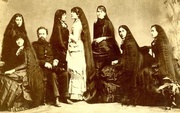

0 comments:
Post a Comment - Back to Post